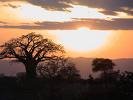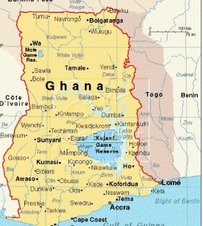Hello Folks! At last I have had both the time and have found an Internet Cafe' to send a report.
In the last few days, we have done everything listed in the title of this blog entry. I will proceed in a matter of fact manner, and try to write more thoughtfully when I get a chance.
On Tuesday, we began a two day journey from Accra to the northern town of Bolgatanga. The van we have was packed very full with our luggage, our boxes of water (and wine), and people. The trip on the road from Accra was filled with many reasons for us to slow down including potholes, road works, and spped bumps. Because the power does not often function speed bumps are used on major roads to slow down the traffic. In the US, you usually hope to travel a mile per minute. Here you hope to travel a kilometer per minute. The infrastructure here is improving. In 1984, we were told that it took approximately 11 hours to travel the 140 kilometers from Tamale' to Bolgatnanga. On Thursday we made the trip in about two hours. On the the first day of the roadtrip, we stopped at the Silicon hotel near Kumasi. It was owned by a man from California who was dedicated to educating folks on the history of the US on civil rights. There were plaques on the wall dedicated to Sojourner Truth, Frederick Douglass, Harriet Tubman, Daisy Bates, and Malcolm X. It was really neat. The trip on wednesday from Kumasi to Tamale' was very long. It took us nearly ten hours, and when we arrived we had to wait because there was amix up on our reservations. The next day we toured an Islamic high school in the morning and preceded to Bolgatanga. The school was an interesting place, but they were in the middle of exams, so we only stayed for about an hour. I met the soccer coach who was very interesting (he has a brother in Atlanta), and we talked about coaching. I gave him two soccer balls, two pumps, and a handful of extra needles. Hopefully, the gift will help him when the new term begins.
We then travled to Bolgatanga, where we checked into the Comme Ci, Comme sa Hotel. It is appropriately named, but the cokes cost about 50 cents and the very large beers are slightly less than a dollar. Life could be a lot worse. We feel the rolling black-outs the country is experiencing, and we have to share a bed with our roomate. I haen't slept in the bed with another man since a soccer trip many years ago. It will be fine. We will be here until tuesday when we travel back to Tamle' and on to Kumasi.
Friday marked my favorite day of the trip so far. We had a potpourri of stops. Our fist stop was a place called the Pinkora Slave Camping Site, which was used byraiders to hold slaves until they had enough to transport them some 500 miles to the cost to the castles at Cape Coast and El Camina. We will visit both of those sites in a couple of weeks. The Pinkora Site was unfortunately a prime example of how humans can take full advantage of what nature provides. On the site there was a well that flowed up through the rocks so that captives could drink. The raiders fed the captives on the ground so thae captives scraped out bowls in the rock. It was very well-preserved. There was also a place where the captives would beat on the rocks with stones while singing songs about resisting the efforts of the raiders breaking their spirit. I nthe brochure the musis was referred to as "rock music". a group of local men played a few songs for us. It was enormously moving. We continued the tour of the facility which was about one square kilometer, and went to the watch post for the raiders. This spot was a location with about three very large rocks naturally stocked, which gave the raiders a good perspective from which to protect their interests. They were there to watch out for locals wishing to rescue their family members who had been captured, and to also thwart the effort of rival raiders looking for the "easy score." The area was subject to attack from three different ethnic groups. One was from present day Mali, one was from present day Burkina Faso, and one was from an area in Ghana that was off to the east. The final stop on the rougly one-hour tour was a spt where captives who were "stubborn" were beaten were often killed to serve as an example. It was truly a stop which will give me a much more complete understadning of a topic in which I have always felt very interested.
We then preced to the nearby Zenga Crocodlile Pond to a village where the crocidile is a totem animal. This means that the animal is sacred and can not be harmed. For a small fee the crocodile guys lured about three or four alligator cousins out of the pond. They then got one of them who was about 89 years old to sit still so we could either sit on its back or hold its by its tail. I held its buy its tail, and will post the picture of me on this blog when I can (which I am starting to believe won't be until I return home in late august. The crocodile was sacred because he led a warrior who was lost many years ago to water and safety. The warrior thanked the croc, and now it is believed that each family in town has a special crocodile dedicated to them. The crocodiles roam the village in the night and will not bother the goats and people of the area. When asked how he knew the crocodies age, the "trainer" said his grandfather lived here when the crocodile was born. It was a really cool story.
We then proceeded a little north and crossed the Burkina Faso border just so that we could say we went into Burkina Faso. I tried an ear of corn cooking on the open grills and a piece of goat meat. Neither is a dish that I am craving to try again, but it was fun to eat. All of the meat here is enormously spicy, and I am having reasonable success eacting the local cuisine. I find myself craving a steak from Garrison's and some soup from Thai Diner near my house. The most interesting part of crossing into Burkina was hearing how people who had historical ties for a very long time spoke English in Ghana and French in Burkina. You got a love that colonialism.
Next, we went to visit a place called the Association Development for People (ADEP). It was a essentially an NGO (like a non-profit organization) designed to grant local (women) farmers micro-credit loans. The average loan is about one new Ghanaian Cedi which is slightly more than a dollar. The group fed us which made me feel like I was stealing, but yo shold have seen the faces of the members when Max informed them that we would be leaving them 100 Ghanaian Cedis. I hink I have found an organization that Lovett can assist with funds to help ADEP provide loans to people who make very little per year. In this area, it is estimated that nine of ten people subsist below the poverty line which is earning about 7 Ghanaian Cedis a year. That equals about $7.50 a year. I will give this internet cafe' a bit more than that for being able to post this entry.
Today, we visited The Sirigu Women's Organization for Pottery and Arts (SWOPA) in the town of Sirigu. They have a website, but the guide did not know the web address. Google it if you wish; the guide said there were some pics and info. It was really fascinating. The whole time I was there I was thinking about how cool Tom Zwirlein would think this place was. The had little rooms that one could rent for about 7 G cedis a day. The place was provided electriciy by solar panels and is part of program that is called eco-tourism, which the slave camp and croc ponds are also a part. The tour guide showed us his own families living complexes. He showed where the millet (a grain) was stored and where the family made decisions led by the elder. There was an intersting story that I had added but due to Internet conncetion troubles that part didn't save. I'll suffice if for now to say the the royal python is a sacred animal here and lives in a portion of each person's home. By for now, check back soon. I am really digging this trip.
Tohajie is out!!!
Saturday, July 21, 2007
Subscribe to:
Posts (Atom)




